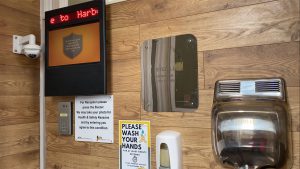 In this blog, Emily Hill from Harbour Housing, a homeless charity in Cornwall, describes how their service has supported people living in temporary accommodation to leave hospital safely during the pandemic. She highlights some of the challenges in making sure everyone has the opportunity to self-isolate when living in a House in Multiple Occupation (HMO) (903 words)
In this blog, Emily Hill from Harbour Housing, a homeless charity in Cornwall, describes how their service has supported people living in temporary accommodation to leave hospital safely during the pandemic. She highlights some of the challenges in making sure everyone has the opportunity to self-isolate when living in a House in Multiple Occupation (HMO) (903 words)
Harbour Housing provides supported accommodation across Cornwall for people with multiple and complex needs, including those who have recent experience of homelessness. The accommodation is provided in what are called Houses in Multiple Occupation (HMOs). Residents have their own rooms but share communal areas such as bathrooms and kitchens.
Clinical advice and guidance on reducing the risk of infection and severe illness among the homeless population as a result of coronavirus (COVID-19) is clear that HMO’s could pose risks. In order to reduce these risks, the guidance suggests that individuals should be provided with their own room and bathroom facilities wherever possible. Where this is not possible, providers should make best use of provision and should undertake regular cleaning of shared facilities.
 The first step in Harbour Housing’s response to keeping residents safe from COVID-19 was to provide everyone with an information briefing, ensuring staff had time to talk through any concerns. Video screens in the properties also relayed NHS advice about hygiene and hand washing. Washing facilities and hand dryers were installed in the entrance lobby at each building. This meant that everyone had the opportunity to wash their hands before entering the property. In addition, thermal imaging CCTV cameras were installed to read the temperature of every person entering the building. This was to ensure that symptoms could be caught early.
The first step in Harbour Housing’s response to keeping residents safe from COVID-19 was to provide everyone with an information briefing, ensuring staff had time to talk through any concerns. Video screens in the properties also relayed NHS advice about hygiene and hand washing. Washing facilities and hand dryers were installed in the entrance lobby at each building. This meant that everyone had the opportunity to wash their hands before entering the property. In addition, thermal imaging CCTV cameras were installed to read the temperature of every person entering the building. This was to ensure that symptoms could be caught early.
Personal Protective Equipment (PPE) has been provided to staff and volunteers. The volunteers are themselves residents (i.e. they live at the property where they are volunteering). They cook meals and deliver them to the rooms of those residents who consider themselves to be more vulnerable, thus increasing opportunities for social distancing.
More challenging has been accommodating residents who have been in hospital and who need to self-isolate for 14 days after discharge. As illustrated through Jasper’s case study below, problems can arise where residents are not considered eligible for the new out-of-hospital care pathways that have been developed in response to COVID-19.
Jasper’s Case Study
Jasper* suffers with poor mental health and self-neglect. He has a partner, Angie, who he refuses to be without. She also has mental health issues. They do not live together but are housed in the same accommodation block after both being homeless together. They have a dog.
Jasper was admitted to hospital due to a suspected heroin overdose. Unable to visit, Angie called an ambulance several times for herself to try and reach him.
Although placed on a COVID-19 ward, Jasper tested negative for the virus. Once clinically fit, there was some pressure to secure a speedy discharge. This was due to his cannabis use. The hospital told us he was in danger of being escorted off site. However, we initially felt that Jasper should not return to his current accommodation because of the need to self-isolate for 14 days. There were 30 other residents living in the block which had shared kitchen and bathroom facilities. There were also concerns about Jasper’s ability to keep to the rules about hygiene and hand washing.
Given these challenges, a multi-agency meeting was convened to find a way forward. However, none of the new COVID-19 pathways out-of-hospital could accommodate Jasper. Older people who could not return home were being placed in local hotels, but it was felt that Jasper may not fit in there because of his challenging behaviour. People who were street homeless were being placed in caravans on holiday parks, but as Jasper had somewhere to live he was not considered eligible for the Homeless Pathway.
As time passed, our frontline support staff began to feel increasingly pressurised to allow Jasper to return to his current accommodation. This was mainly due to the huge demand for NHS beds but also because of fears that the longer Jasper stayed in hospital he may catch the virus. To enable Jasper to return home directly from hospital some urgent adaptations were made to the property. A wing of the property was completely shut off from the rest of the house, and Jasper was moved into one of the rooms. Angie was then moved into the adjacent room with their dog. The wing comprised four rooms, so the original residents had to be relocated, with building works fast tracked to make other rooms in the facility habitable for them. This arrangement also left the other two rooms in the wing empty, unable to be used. Jasper and Angie (and their dog) were then able to successfully and happily self-isolate together in the self-contained wing, receiving support from staff for the period.
In this case, the ideal solution was found for Angie and Jasper who were very happy with these arrangements. However, we are left with the concern that because of the cost and lack of room space we could not do this for many more of our residents. It is important therefore that the new routes out-of-hospital recognise the needs of people living in HMO’s as well as those who may be street homeless.
*Client’s name has been changed
Emily Hill works at Harbour Housing, a charity providing accommodation and support to people with complex needs experiencing homelessness across Cornwall.